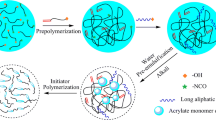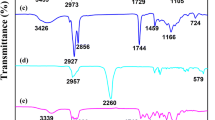Abstract
Self-crosslinkable aqueous polyurethane (PU)/polyacrylate (PA) composite emulsion was obtained by radical copolymerization. Fourier transform infrared spectroscopy (FT-IR) result shows that the cross-linking reaction between the carbonyl group and the hydrazine group has happened. The influence of the hydrazide-carbonyl molar ratio and the PA content on the properties of the composite emulsions and their films were investigated. The results show that, under the optimal hydrazide-carbonyl molar ratio (n (hydrazine group)/n (carbonyl group) =1:1), the water absorption is 10.56 %, and the mechanical properties and thermal stabilities are both improved. As the PA content increases from 0 wt% to 15 wt%, the tensile strength increases from 5.7 MPa to 7.3 MPa and the gel content increases from 70.3 % to 87 %.








Similar content being viewed by others
References
Lu YS, Richard CL (2007) New hybrid latexes from a soybean oil-based waterborne polyurethane and acrylics via emulsion polymerization. Biomacromolecules 8:3108–3114. doi:10.1021/bm700522z
Biemond GJE, Braspenning K, Gaymans RJ (2008) Polyurethanes with monodisperse rigid segments based on a diamine–diamide chain extender. J Appl Polym Sci 1072:180–2189. doi:10.1002/app.27282
Ioan S, Mihaela L, Epure V, Ioanid A, Macocinschi D (2008) Macromolecular assemblies of segmented poly(ester urethane)s and poly(ether urethane)s. J Appl Polym Sci 107:1414–1422. doi:10.1002/app.24562
Yang HY, Zhang XM, Duan LJ, Zhang MY, Gao GH, Zhang HX (2012) Synthesis and characterization of fluorescent PEG-polyurethane with free carboxyl groups. J Polym Res 19:1–7. doi:10.1007/s10965-012-9973-7
Potolinca V, Buruiana E, Oprea S (2013) Dielectric behavior of polyurethane and polyurethane-urea elastomers with pyridine moieties in the main chain. J Polym Res 20:1–9. doi:10.1007/s10965-013-0237-y
Wang L, Shen YD, Lai XJ, Li ZJ, Liu M (2011) Synthesis and properties of crosslinked waterborne polyurethane. J Polym Res 18:469–476. doi:10.1007/s10965-010-9438-9
Brown RA, Coogan RG, Fortier DG, Reeve MS, Rega JD (2005) Comparing and contrasting the properties of urethane/acrylic hybrids with those of corresponding blends of urethane dispersions and acrylic emulsions. Prog Org Coat 52:73–84. doi:10.1016/j.porgcoat.2004.03.009
Peruzzo PJ, Anbinder PS, Pardini OR, Vega J, Costa CA, Galembeck F, Amalvy JI (2011) Waterborne polyurethane/acrylate: comparison of hybrid and blend systems. Prog Org Coat 72:429–437. doi:10.1016/j.porgcoat.2011.05.016
Zhang T, Wu WJ, Wang XJ, Mu YP (2010) Effect of average functionality on properties of UV-curable waterborne polyurethane-acrylate. Prog Org Coat 68:201–207. doi:10.1016/j.porgcoat.2010.02.004
Nakayama Y (2010) Development of novel aqueous coatings which meet the requirements of ecology-conscious society: novel cross-linking system based on the carbonyl–hydrazide reaction and its applications. Prog Org Coat 51:280–299. doi:10.1016/j.porgcoat.2004.07.010
Tillet G, Boutevin B, Ameduri B (2011) Chemical reactions of polymer cross-linking and post-crosslinking at room and medium temperature. Prog Polym Sci 36:191–217. doi:10.1016/j.progpolymsci.2010.08.003
DEP Mestach, MJJ Weber, G Delaunoit, WLS Pilaszek, Aqueous crosslinkable polymer compositions for use in coatings. EP Patent 989163
Hirose M, Zhou JH, Nagai K (2000) The structure and properties of acrylic-polyurethane hybrid emulsions. Prog Org Coat 38:27–34. doi:10.1016/S0300-9440(99)00081-8
Fadida T, Lellouche JP (2012) Poly-N-(4-benzoylphenyl)methacrylamide nanoparticles: preparation, characterization, and photoreactivity features. J Polym Res 19:1–12. doi:10.1007/s10965-012-0023-2
He LB, Chao DM, Wang XT, Jia XT, Wang C, Liu XC (2012) Synthesis and properties of novel electroactive poly(aryl ether ketone) bearing oligoaniline segments. J Polym Res 19:1–8. doi:10.1007/s10965-012-9999-x
Chai SL, Jin MM, Tan HM (2008) Comparative study between core-shell and interpenetrating network structure polyurethane/polyacrylate composite emulsions. Eur Polym J 44:3306–3313. doi:10.1016/j.eurpolymj.2008.07.038
Wang C, Chu F, Graillat C, Guyot A, Gauthier C, Chapel JP (2005) Hybrid polymer latexes: acrylics-polyurethane from miniemulsion polymerization: properties of hybrid latexes versus blends. Polymer 46:1113–1124. doi:10.1016/j.polymer.2004.11.051
Owens DK, Wendt RC (1969) Estimation of the surface free energy of polymers. J Appl Polym Sci 13:1741–1747. doi:10.1002/app.1969.070130815
Xin H, Shen YD, Li XR (2011) Novel cationic polyurethane-fluorinated acrylic hybrid latexes: Synthesis, characterization and properties. Colloid Surf A 384:205–211. doi:10.1016/j.colsurfa.2011.03.056
Korpela FJ, Pakkanen TT (2011) Incorporation of polydimethylsiloxane into polyurethanes and characterization of copolymers. Eur Polym J 47:1694–1708. doi:10.1016/j.eurpolymj.2011.06.006
Alarcia F, de la Cal JC, Asua JM (2006) Continuous production of specialty waterborne adhesives: Tuning the adhesive performance. Chem Eng J 122:117–126. doi:10.1016/j.cej.2006.05.015
Sardon H, Irusta L, Fernández-Berridi MJ (2010) Synthesis of room temperature self-curable waterborne hybrid polyurethanes functionalized with (3-aminopropyl) triethoxysilane (APTES). Polymer 51:5051–5057. doi:10.1016/j.polymer.2010.08.035
Bai CY, Zhang XY, Dai JB, Zhang CY (2007) Water resistance of the membranes for UV curable waterborne polyurethane dispersions. Prog Org Coat 59:331–336. doi:10.1016/j.porgcoat.2007.05.003
Rippel MM, Leite CAP, Lee LT, Galembeck FJ (2005) Formation of calcium crystallites in dry natural rubber particles. Colloid Interf Sci 2:449–456
Braga M, Costa CAR, Leite CAP, Galembeck F (2001) Scanning electric potential microscopy imaging of polymer latex films: detection of supramolecular domains with nonuniform electrical characteristics. J PhysChem B 105:3005–3011. doi:10.1021/jp002667d
Zhu XH, Tu WP, Hu JQ (2006) Preparation and characterization of two-component waterborne polyurethane comprised of water-soluble acrylic resin and HDI biuret. Chin J Chem Eng 14:99–104. doi:10.1016/S1004-9541(06)60044-X
D Mestach, M Weber, G Delaunoit, W Pilaszek, Aqueous crosslinkable polymer compositions for use in coatings, EP Patent 989163
Jia QM, Zheng MS, Shen RJ (2006) Synthesis, characterization and properties of organoclay-modified polyurethane/epoxy interpenetrating polymer network nanocomposites. J Polym Int 55:257–264. doi:10.1002/pi.1931
Wang X, Xing WY, Zhang P, Song L, Yang HY, Hu Y (2012) Covalent functionalization of graphene with organosilane and its use as a reinforcement in epoxy composites. Compos Sci Technol 72:737–743. doi:10.1016/j.compscitech.2012.01.027
Lai XJ, Shen YD, Wang L (2011) Preparation and properties of self-crosslinkable polyurethane/silane hybrid emulsion. J Polym Res 18:2425–2433. doi:10.1007/s10965-011-9656-9
Li XR, Fei GQ, Wang HH (2006) Mechanical and surface properties of membranes prepared from waterborne cationic hydroxyl-terminated polydimethylsiloxane/polyurethane surfactant-free micro-emulsion. J Appl Polym Sci 100:40–46. doi:10.1002/app.22524
Zhu XL, Zhang QS, Liu LL, Kong XZ, Feng SY (2007) Synthesis and characterization of a new compound bearing ketone and hydroxyl groups for preparation of ambient temperature self-crosslinking waterborne polyurethanes. Prog Org Coat 59:324–330. doi:10.1016/j.porgcoat.2007.05.001
Liu X, Fan XD, Tang MF (2008) Synthesis and characterization of core-shell acrylate based latex and study of its reactive blends. Int J Mol Sci 9:342–354. doi:10.3390/ijms9030342
Acknowledgments
This project was supported by the Graduate Innovation Fund of Shaanxi University of Science and Technology, and the authors thank the National Natural Science Foundation of China (contract grant number: 50973057; 51103081) for financial support.
Author information
Authors and Affiliations
Corresponding author
Rights and permissions
About this article
Cite this article
Li, X., Wang, X., Shen, Y. et al. Synthesis and characterization of self-crosslinked polyurethane/polyacrylate composite emulsion based on carbonyl–hydrazide reaction. J Polym Res 20, 270 (2013). https://doi.org/10.1007/s10965-013-0270-x
Received:
Accepted:
Published:
DOI: https://doi.org/10.1007/s10965-013-0270-x




